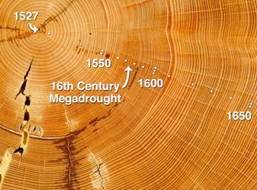Friday, October 5, 2012
Climate change could cripple southwestern U.S. forests
This Douglas-fir sample from the Southwest has annual tree rings dating back to the year 1527. Daniel Griffin.
Combine the tree-ring growth record with historical information, climate records, and computer-model projections of future climate trends, and you get a grim picture for the future of trees in the southwestern United States.
A. Park Williams of Los Alamos National Laboratory in New Mexico is the lead author of the paper, "Temperature as a potent driver of regional forest drought stress and tree mortality." (Full Story)
This story also appeared in Fronteras and the Santa Fe Reporter
Powering Curiosity on Mars — and beyond
A multi-mission radioisotope thermoelectric generator (MMRTG) at NASA’s Kennedy Space Center. NASA photo.
Curiosity, which is significantly larger and at least 10 times heavier than previous Martian rovers, uses a new generation RTG, the “Multi-Mission Radioisotope Thermoelectric Generator (MMRTG),” a device assembled and tested by researchers at Idaho National Laboratory, with components from Los Alamos National Laboratory and Oak Ridge National Laboratory, and assessed for nuclear safety by Sandia National Laboratories.
The device will give the mission on Mars’ surface an operating lifespan of a full Martian year (687 Earth days, a little less than two Earth years) over a wide latitude range. (Full Story)
Geoffrey West finds the physical laws embedded in human cities
Geoffrey West. From Discover.
Early in your career, you co-founded the high-energy physics group at Los Alamos. What was that like?
We had some amazing people there. Many of us played an important role in helping to develop what became known as the Standard Model of physics, which is our best mathematical description of the fundamental forces and particles. And because of the huge computing power at Los Alamos, we worked on simulating the theory on a computer rather than using the traditional analytic mathematical techniques of the time. (Full Story)
Questa couple pursues college degrees thanks to LANL Foundation’s assistance
Santana García-Chang, left, discusses a drainage stabilization field project at Los Alamos National Laboratory with mentor Debbie Apodaca Pesiri. LANL photo.
When Questeña Santana García-Chang saw a video about the Los Alamos National Laboratory’s employee scholarship fund she thought, “I want to be in that.”
García-Chang and Francisco “Kiko” Rael hang out with scientists and engineers at their adopted home in Los Alamos. Their days are busy: caring for 2 1/2-year-old son, Javan, working 25 hours a week at Los Alamos lab, she an intern, he a contractor. (Full Story)
LANL tops records in first year of accelerated shipping
Another TRU waste shipment heads for WIPP. LANL photo.
In the first year of an effort to accelerate shipments of transuranic (TRU) waste to the Waste Isolation Pilot Plant (WIPP), Los Alamos National Laboratory topped its own record with 59 more shipments than planned, and it also became one of the largest shippers of this type of nuclear waste in the country. (Full Story)
Coalition gets $100,000 grant
A coalition of local governments formed to advocate on various issues related to Los Alamos National Laboratory has received a $100,000 grant from the National Nuclear Security Administration’s Los Alamos Site Office. (Full Story)
To subscribe to Los Alamos Report, please e-mail listmanager@lanl.gov and include the words subscribe losalamosreport in the body of your email message; to unscubscribe, include unsubscribe losalamosreport.
Please visit us at www.lanl.gov
And follow us on Facebook, Twitter, YouTube, and Flickr











